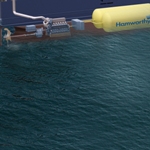Hamworthy Selected For Gas-Powered Ships
 Hamworthy has signed a contract to install liquefied natural gas (LNG) storage tanks and fuel systems onboard four gas-powered ferries to be constructed at the Remontowa Shipyard in Gdansk, Poland. The ships, which will be delivered to shipowner Torghatten Nord AS, will serve two routes across Vestfjorden in Lofoten in the north of Norway. Both routes are known for their harsh operating conditions.
Hamworthy has signed a contract to install liquefied natural gas (LNG) storage tanks and fuel systems onboard four gas-powered ferries to be constructed at the Remontowa Shipyard in Gdansk, Poland. The ships, which will be delivered to shipowner Torghatten Nord AS, will serve two routes across Vestfjorden in Lofoten in the north of Norway. Both routes are known for their harsh operating conditions.
The ships are planned for for delivery in the second half of 2012. Hamworthy Oil & Gas Systems will deliver the fuel gas systems as sub-supplier to Rolls-Royce, which has been awarded the contract for complete propulsion systems. Each ship, being built in Hanjung Shipyard, China, will each feature 150m3 capacity storage tanks designed by Hamworthy.
Promising
Reidar Strande, Hamworthy Oil and Gas Systems Director LNG, said “LNG is a promising fuel for ships, with greatly reduced emissions compared to regular marine diesel or heavy fuel oil. Due to the establishment of the Emission Control Area for the Baltic Sea and parts of The North Sea a lot of new ships are being equipped with gas engines. By utilising natural gas, SOx, NOx and particulate matter emissions are reduced by up to 80%, while carbon dioxide can be reduced by between 15% and 25%.”
Fuel Handling
Mr Strande said that since natural gas has to be bunkered as LNG, special requirements for fuel handling had to be met: “The fuel has to be evaporated and warmed before it may be used as fuel in a gas engine. Hamworthy Oil & Gas Systems has extensive experience in handling cryogenic liquids and is today utilising this experience as supplier of fuel gas systems for modern gas engine ships.” Hamworthy will deliver the complete storage and handling systems, including bunkering stations on board to handle refilling of the ships’ 150 cu. m LNG tanks in less than one hour and evaporation and heating of the LNG from approximately -145°C to +30°C. “To meet strict maritime requirements the systems are fully redundant, guaranteeing fuel supply under any circumstance”, said Mr Strande. “No fuel pumps are necessary. Natural gas will rather be delivered to the engines by differential pressure between tank and engine. Tank pressure is maintained by controlled evaporation of LNG in a closed cycle with the fuel tank. Bunkering lines and gas lines to the engine are normally installed in ventilated ducts, to eliminate risk of explosion or fire.”






